Plastic wells for drainage: device, types, classification, installation instructions
The technology of the drainage system provides for the installation of wells that differ in purpose. They are needed to monitor the operation of the underground pipeline, regular maintenance and periodic cleaning. Previously, they were assembled from concrete rings, but now products from polymeric materials are used.
Lightweight and durable plastic drainage wells make the construction process much easier. Polymer products are resistant to mechanical, chemical and biological influences. Manufacturers of products thought out all the details, providing simplicity and high speed of installation.
We will tell you how to choose the right polymer structures for the drainage system and how to install them. The article presented for review details step-by-step instructions. Following our advice, you can quickly arrange an effective drainage on a suburban area.
The content of the article:
Classification of drainage system wells
To save the territory from rain and melt water, it is not enough to install drainage pipes and trays on the site. The same applies to moisture in the soil, drainage pipes alone will not be enough, because the liquid collected by him must be diverted somewhere. For this, a system is created from underground pipelines, an integral part of which are plastic wells.
There are several different types of such structures, each of which has its own purpose. They have different sizes and the number of entries, can be with a sealed bottom and without it. And all this variety of devices is now made of plastic.
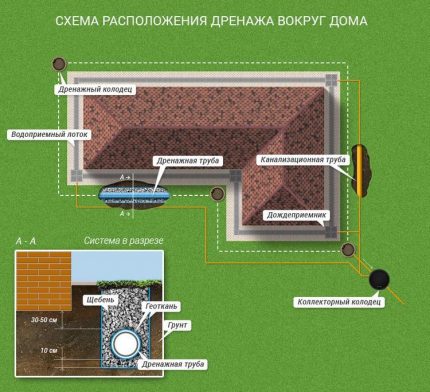
Types of facilities by functionality
In the drainage systems, six varieties of plastic wells with various functional purposes are used:
- Collector. In the suburban areas, one collector well is arranged to receive drains of all types of sewer systems. If there is a need to stimulate the movement of effluents, it is equipped with a pump. If it is planned to unload the system into the underlying layer, they are constructed without a bottom like filtration ones.
- Lookouts. Arranged for system revision and periodic cleaning. Located at turning points, forming nodes or connecting to central highways.
- Overflow. They are installed in the joints of pipelines laid at different depths. They are also used when necessary to reduce the speed of gravity flow or when crossing any underground structures. In drainage systems are practically not used.
According to the type of access to the maintenance of systems, the wells are divided into serviced and inspection ones. The first type provides access to the network sections passing in the well for maintenance, the second provides for repair and other operations from the ground.
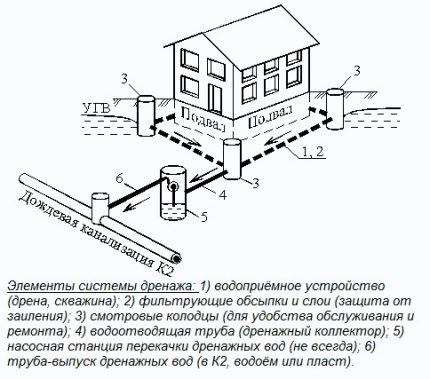
The functionality of the wells is different, but they are structurally similar. In general, it is a vertically oriented reservoir in the ground that has two or more outlet and inlet openings. Often, one well combines a number of significant functions. But in most cases, each of them is mounted for any one role.
Manhole inspection structures are designed to inspect and maintain the entire system. One side manholes allow you to monitor the condition and throughput of pipes, controlling the level of clogging, and on the other hand, pipelines are cleaned from them.
Swivel type of manholes are used when it is necessary to turn the flow of water by 90º. Linear ones are installed on straight sections after an average of 50 meters, but the allowable distance interval between them is 40 - 150 m.
If the system is supposed to be flushed manually with a descent into the well, then it should be a diameter of one meter or more.In other cases, a construction with a diameter of 35-50 cm is enough. Just enough to let the hose for flushing or pumping out without problems.
Accumulative or collector options are large containers in which the accumulation of effluents takes place for the subsequent movement of drainage effluents to discharge points. This may be a nearby body of water with standing or running water, storm sewers.

Well, filter-based, allows you to drain water into the underlying groundwater aquifers, taking it away from the foundations of buildings.
However, it is permissible to arrange it only on sandy soils, gravel or pebble deposits with sand aggregate. Those. on soils with good filtration qualities equal to the ability to absorb water.
The entire system of pipelines and wells is built in such a way that the last structure in the chain is at the lowest point of the drained territory. It is in the drive, filtering or collector well, that all water from the site must drain.
In this case, it is desirable that the movement of water took place by gravity. In the event that the device of a gravity-flowing system is not possible according to technical specifications, the collector well is equipped with a pump to stimulate the movement of water.
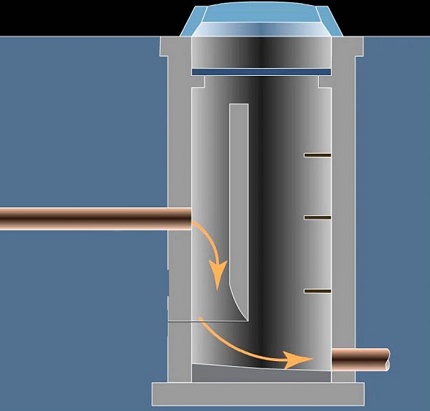
Overflow wells according to the internal arrangement differ in:
- chambers with one water damper inside;
- collectors with a water stripper system;
- high shafts with a lead-in from above and a downpipe from below;
- constructions from a pair of independent sections connected by an overflow channel at an angle.
In some cases, the flow energy is extinguished by the bottom, and in others this is due to special chippers. The choice of a specific option depends on the level of the difference between the sewage pipes, as well as the relief of the site and the characteristics of the soil layers on it.
Polymers used in the manufacture
In the manufacture plastic wells For drainage, polymers of various structures and different technologies are used. The cheapest products are obtained on rotary forming machines. They are most often found in domestic stores.
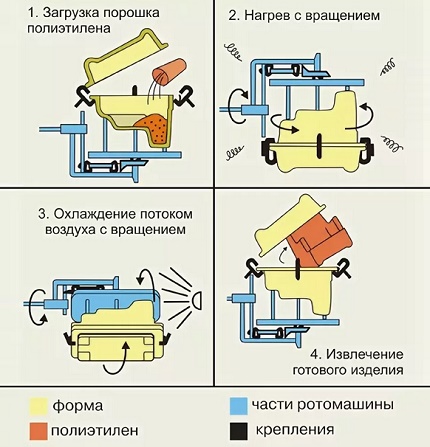
Wells are produced using the following polymers:
- PVC (PVC) - polyvinyl chloride.
- PP (PP) - polypropylene.
- PE (PE) - ordinary and high density polyethylene.
Most often one of them is used with some kind of placeholder, but various combinations are not uncommon. Various components can be added to the resulting plastic: from dyes to sand.
Polyvinyl chloride products are the most resistant to the effects of aggressive chemicals that enter inside with effluents.
They are even used in the construction of sewer systems at industrial enterprises. Polypropylene cases are characterized by high wear resistance and ductility, but they become quite fragile with a strong decrease in temperature.
Polyethylene drainage wells are resistant to frost. They can freeze, but after thawing this element of engineering communications quickly regains its shape without losing tightness. This is the best option for moving soils.
The advantages of plastic products
Among the advantages of plastic wells for drainage are:
- Light weight, which allows without a crane during loading / unloading and installation.
- Resistant to aggressive environments, mechanical damage and low temperatures, the body material.
- Service life of 50–70 years without major repairs.
- The presence in the case of all the necessary inputs and outputs of the factory version.
- The minimum amount of excavation due to thin walls and a reduced diameter of the well structure.
- Extremely simple installation - a plastic product is easily cut to the desired size.
- The strength of the structure, which is able to withstand tens of tons of load from above and the accumulation of soil in winter from the sides.
The lightness of the plastic elements of the well housing allows all installation work to be performed by a couple of people. But in this lightness lies the main drawback of plastic wells - during floods and swellings they can be banally squeezed out of the ground.
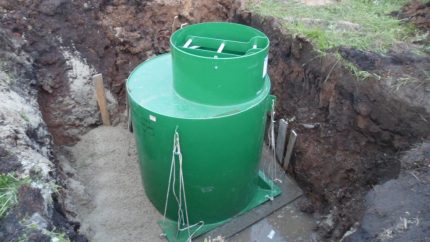
Another relative drawback is the high price of a plastic drainage well. However, it is worth considering not only the cost of the product itself, but also the cost of its installation. In the case of a plastic construction, you don’t have to order lifting equipment, a couple of installers and ropes will be enough to lower the assembled elements into the pit.
Given the long life of several decades without major repairs, the price no longer seems so overpriced. The initial cost of a plastic well pays off.
In addition, it is much easier to connect pipes to it than to a concrete or brick counterpart. Specialized skills for its installation will not be required, it will not be necessary to invite highly qualified specialists.
Plastic well device
Structurally well construction made of plastic includes:
- conical neck;
- a circular working chamber (shaft);
- sand collecting tray and bottom.
Instead of a sealed bottom, a drainage cushion made of gravel can be arranged, because leakage of drainage water during the repair of the system is not dangerous for underlying soils and the environment.
From above, the entire structure is closed by a hatch or a conventional cover. They are made of plastic, cast iron or polymer sand. In this case, the neck of the well tank may be absent, then the hatch is laid directly on the shaft.
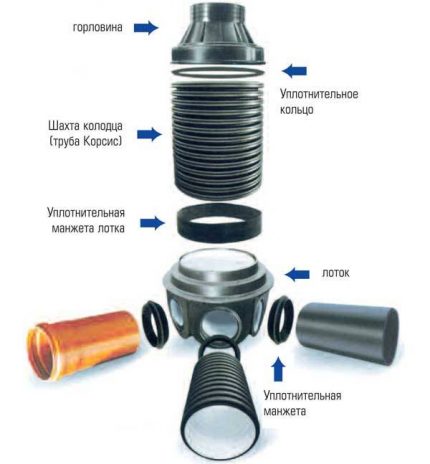
The mine is made corrugated, so its strength characteristics increase. When compressed by soil, it will not collapse, remaining intact and tight.
The bottom and the tray with pipes make up the kinetic part of the well, where pipe wiring is arranged. Also, all trash and sludge falling inside it with drains settles in it. Often, a special form is supplied with them for pouring a concrete support base (“anchors”).
When installing a sealed well structure for a drainage system, it is permissible not to use a tray. Instead, you can install a simple flat bottom. So the design is cheaper, but this option is more prone to clogging with large debris. You will often have to look into the well shaft for the purpose of inspection, and at the slightest clutter - immediately clean it.
Inside the well, a hinged staircase can be built in or steps can be made in the form of inserts into the body. Pipelines are connected to special holes cut at the factory. Also, a similar insert can be made at almost any point in the body.
Details on the classification of plastic wells, their design features and scope are described. in this article.
Which is better: precast vs monolithic?
A prefabricated drainage well is assembled from various plastic parts, like a constructor.The monolithic product is already ready for installation, it only needs to be lowered into a hole dug for this.

Monolithic options are cheaper and stronger than their prefabricated counterparts. However, they are available in a fairly narrow range of standard sizes. Their installation is carried out only to the depth specified in the instructions.
Separate elements of a prefabricated structure are easier to transport and load in a car than a single-piece product of large sizes. But in terms of compressive strength, even in the assembled state they are inferior to the initially solid well. A solid casing, by definition, can withstand large hydrodynamic and mechanical loads.
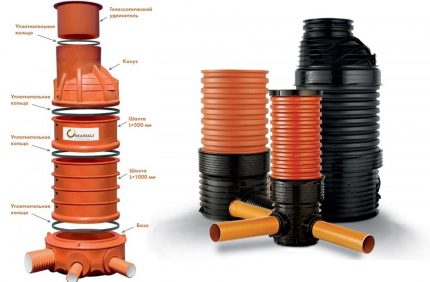
The assembly of plastic parts for a drainage well involves the need to seal their joints. And each such junction is a potential gap and leak.
Plus, to tighten the elements, you need bolts with nuts. They should be included. If they are not, then buy only galvanized fasteners, less susceptible to corrosion.
Plastic drainage well installation technology
If a prefabricated structure is selected, then it must first be assembled. You can do this in the foundation pit, but then you will have to dig it up in a larger size.
The depth of the pit under the plastic drainage well breaks out so that the pipes enter it below the freezing point of the soil and above the upper aquifer in it. It is worth remembering that under the construction it will still be necessary to pour a crushed stone pillow of 10-15 cm and lay a concrete anchor plate of a similar thickness.
If a plastic well will be used to drain moisture into the soil, then the layer of rubble at the bottom should be at least 30–40 cm. In this case, a large hole will have to be digged.
The width of the pit is 30–50 cm larger than the outer diameter of the mounted tank. This is quite enough to lower the plastic product inside, and you won’t have to dig extra land.
In height, the well structure is selected so that it cannot rise more than 20 cm above the ground. The only exception is the catchment option with a grill on top instead of a cover.
Hatches of all other types of drainage system wells should be located 10–20 cm above the level of turf. Otherwise, during the rain, water streams will begin to flow into them, carrying with them foliage and other garbage.
If groundwater regularly rises to the surface in spring, then a concrete base under a plastic well must be made without fail. Between themselves they are connected by a nylon cable, which certainly does not rot in the ground. An anchor made of concrete is not needed only in areas with dense rocky soils.
To cut additional holes, you will need a milling cutter of the appropriate size. After making a hole, a rubber sealant is inserted into it, into which a transition sleeve is placed. The latter should go into the rubber gasket tightly without gaps.
To do this, they must have the same size. In order to seal the joints, they are lubricated with silicone grease, which facilitates the pressing of the coupling and at the same time forms a tight joint.
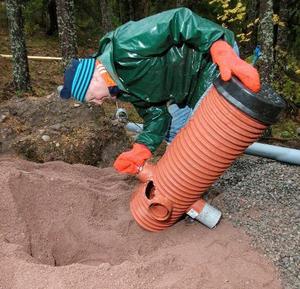
Then perforated are connected to the well installed in the pit drainage pipes and sealed sewer pipes needed to drain the collected drainage water.
To ensure free movement of water collected by the drainage stacked with a slope. So, under the influence of its own weight, water will spontaneously flow towards the reservoir, collector or filter well.
And then it remains only to backfill the pit with soil or a sand-cement mixture. This is done evenly and in layers, so as not to sharply squeeze the plastic housing and not destroy it. A hatch is placed on top, installation is completed.
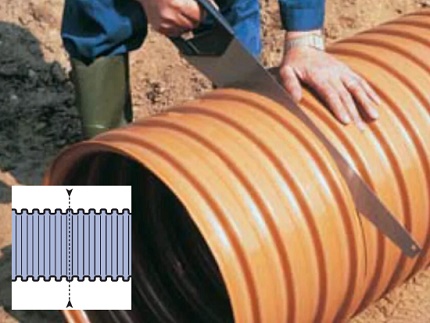
Well insulation
Drinking and sewer wells should be covered with insulating material. They are used year-round, while the water in them should not freeze.
But with designs site drainage system the situation is somewhat different. They are not used in winter. Frosts in spring and autumn for plastic wells are not terrible. By all means, they are not required to be insulated.
However, if there is a desire to perform thermal insulation, then the ideal option here is polystyrene sheets. This material is not afraid of moisture and cold.
Conclusions and useful video on the topic
Video # 1. Insertion technology into a plastic pipe body using a sleeve:
Video # 2. Overview of drainage wells from different manufacturers:
Video # 3. Step-by-step installation of a well structure made of plastic:
A well made of plastic, intended for use in a drainage system, is a practical, durable and easy-to-install product. For its installation you will not have to involve construction equipment.
A variety of prefabricated and standard sizes of monoblock structures makes it possible to arrange any drainage systems of any complexity.It is only necessary to choose their model in accordance with the functional purpose.
Please write comments in the block below. Here you can ask a question or tell about your own experience in installing plastic wells. Share interesting facts and photos on the topic of the article.

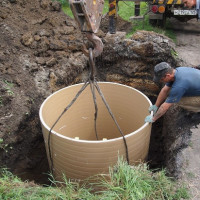 Viewing wells for drainage: types, arrangement and installation features
Viewing wells for drainage: types, arrangement and installation features 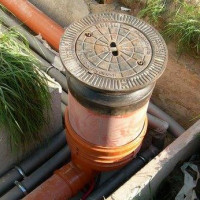 Plastic sewer wells: varieties + installation features
Plastic sewer wells: varieties + installation features 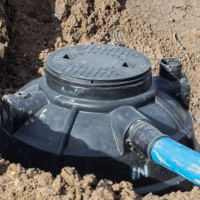 Sewer wells: full classification and examples of arrangement
Sewer wells: full classification and examples of arrangement 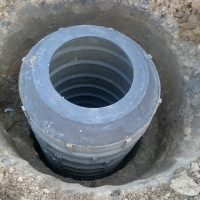 Polymer-sand wells: device, advantages and disadvantages, installation rules
Polymer-sand wells: device, advantages and disadvantages, installation rules 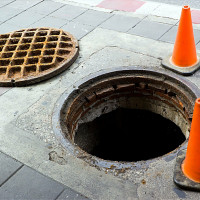 Sewer manholes: a review of species, their sizes and classification + what to look for when choosing
Sewer manholes: a review of species, their sizes and classification + what to look for when choosing 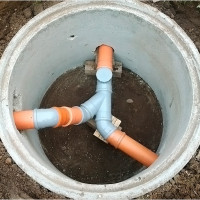 Manhole for sewage: installation of a well in storm and sewage systems
Manhole for sewage: installation of a well in storm and sewage systems  How much does it cost to connect gas to a private house: the price of organizing gas supply
How much does it cost to connect gas to a private house: the price of organizing gas supply  The best washing machines with dryer: model rating and customer tips
The best washing machines with dryer: model rating and customer tips  What is the color temperature of light and the nuances of choosing the temperature of the lamps to suit your needs
What is the color temperature of light and the nuances of choosing the temperature of the lamps to suit your needs  Replacement of a geyser in an apartment: replacement paperwork + basic norms and requirements
Replacement of a geyser in an apartment: replacement paperwork + basic norms and requirements
I choose a solid version of plastic wells. On my site there are continuous clay soils. The layers lie in a thick layer close to the surface, in some places loam is opened at a depth of 0.5 m. During freezing, such rocks “walk with a sway” and can damage any joints. Wells are necessary for the site for revision and as storage tanks for removing water during heavy rains and snow melting. It was difficult to walk without drainage in the area, even in rubber boots.
I plan to do drainage and I will probably put prefabricated plastic wells. I did not find a monolithic suitable size for me. Which silicone grease is best used to seal joints? I mean from any particular brand or anyway?
Hello. In your case, it also depends on the size of the well, as well as the types of geometry of the joints. Of the tested options, I can recommend polymer welding - this is the most optimal option, better than any sealants.
So you can achieve complete tightness of the well, even in the most inaccessible places. Factory seals can be used to connect between the pipes inside the well. And how big are you planning? I know that there are different sizes of plastic options. Or will you have non-standard geometry?